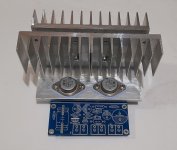As a result, the modification circuit for a unipolar supply voltage took on the following form:
View attachment 1282416
Surely C4 is the wrong polarity?
Surely C4 is the wrong polarity?
yes, that's right.
This means that at least someone is looking at the diagram)))
Now in the process I am making a radiator for the second channel in a more compact form, the area is 704 cm2.
If we look for the calculated value, we first determine the thermal resistance of the radiator is , at an overheating temperature of 60 degrees Celsius and the required power dissipation of the amplifier 32.5W, we obtain that
Q = 60/32.5 = 1.85 degrees C/watt.
From here we calculate the required radiator area:
S = quare (50/1.85) = 730cm2.
It turns out to be completely within the boundaries of the calculation, even a little lacking. This means that when installing the unit in the amplifier case, it will be necessary to replace the fin block (the rear one is removable) with a radiator block, which will increase the total radiator area to 900 cm2.
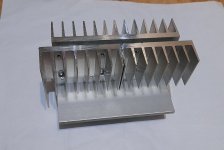
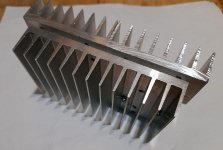
If we look for the calculated value, we first determine the thermal resistance of the radiator is , at an overheating temperature of 60 degrees Celsius and the required power dissipation of the amplifier 32.5W, we obtain that
Q = 60/32.5 = 1.85 degrees C/watt.
From here we calculate the required radiator area:
S = quare (50/1.85) = 730cm2.
It turns out to be completely within the boundaries of the calculation, even a little lacking. This means that when installing the unit in the amplifier case, it will be necessary to replace the fin block (the rear one is removable) with a radiator block, which will increase the total radiator area to 900 cm2.


and it seems to work - lower level gets better performance, -80dB for H2 or so at around 1/2 full scale, and clipping is relatively soft.
Yes, I trust my modeling simulator, because practical production confirmed what was calculated in the model in other amplifiers. Now I have channel 1 working all evening, a really soft, not tense sound. The option with 4 pairs did not work so smoothly for me.
Thanks for the topology suggestion. I also considered this option, and purely mathematically it seems to be good, because increases the open loop gain by +20 dB, which reduces the measured distortion, but there is always one “but”, while the upper cutoff frequency open loop of the 2 stages is reduced from 26 kHz to 6 kHz.You could also convert the second transistor/stage into a Darlington
Firstly, this has nothing to do with ultralinearity, and secondly, an increase in the depth of the NBF in this design leads to an increase in dynamic distortions, which are not related to the measured distortions, but greatly affect the sound quality,
Previously, I already wrote about the need to select elements of the RCR circuit with tracking coupling in the driver load, the reason is the same - with increasing impedance in the speaker system at high frequencies, the gain of the open loop also increased with increasing frequency, which led to dynamic distortion, so I equalized the P values in this circuit in order to minimize this dependence.
If we talk about the prospects of “topological acrobatics” in the circuit, then for me the most optimal is the use of a bipolar supply voltage and the exclusion of all electrolytic capacitors from the audio signal path.
This option (see attachment) adds transistor Q9 according to a common base circuit, it minimizes the influence of the load impedance on the collector circuit of the driver transistor.
As a result, there is an almost complete absence of higher harmonics.
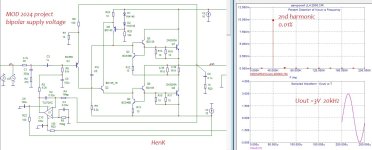
This option (see attachment) adds transistor Q9 according to a common base circuit, it minimizes the influence of the load impedance on the collector circuit of the driver transistor.
As a result, there is an almost complete absence of higher harmonics.

As for the modification of JLH 1969, the option from the post is enough: https://www.diyaudio.com/community/threads/hennadys-take-on-the-1969-jlh.409972/post-7620795I am excited to see where your design journey will take us. And whether final measurements on the object will confirm the simulation results.
further - there will be a different topology, I’ll just take into account the nuances from the modification of the JLH in the future. when will this happen? I don't know.
Last edited:
Somehow I started to think how much distortion in this topology could be reduced and whether there was room for improvement. I slightly adjusted the input part of the amplifier, and.... "like this":I am excited to see where your design journey will take us.
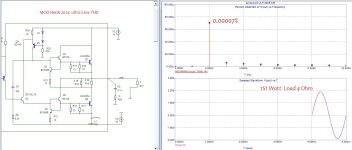
Suddenly.... the gain of the open loop at the frequency at which the distortion data showed was only 74 dB, and there is still the possibility of increasing it by +30 dB, this is a future prospect.
Thank you for giving me the opportunity to look further than I even imagined when I started modifying JLH...
Last edited:
Hi. Can we use Jlh output capacitors as a filter for full range assisted with woofers? For example can we use 220uf -1000uF capacitors for 4 ohm fullranges for using them over 100hz frequency ? Does it harm the amp / speakers?
If you want to reproduce the full range above 100Hz, You can choose the capacitance value of the output capacitor as follows; for a 4 ohm load, an output capacitor with a capacity of 220 μF will suit you. However, keep in mind that this is a first order filter, so the subwoofer must have a phase shifter to minimize the interference of frequencies below 100Hz due to the 1st order filter.
This is the option we got with a microcircuit at the input.
This operational amplifier solution should be considered as a pre-amplifier for the HenK 2024 MOD:
*it does not have an input capacitor
In terms of overall dimensions - the input part on the operational amplifier fits the size of an input capacitor.
You can use TL072 as an operational amplifier - HF distortion will increase - but this is all in thousandths of a percent.
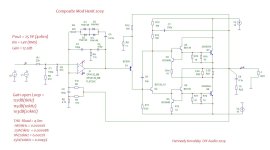
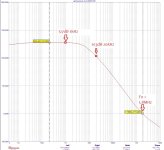
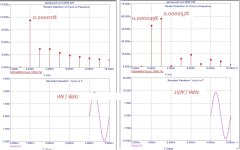
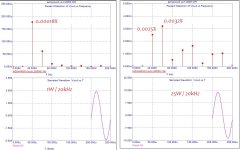
This is an unexpected development of the JLH modification.
This operational amplifier solution should be considered as a pre-amplifier for the HenK 2024 MOD:
*it does not have an input capacitor
- there is an anti-clip link R4/D1-D4/C5
- output amplifier circuit unchanged
- the circuit with tracking power R12R13C7 is also left unchanged.
In terms of overall dimensions - the input part on the operational amplifier fits the size of an input capacitor.
You can use TL072 as an operational amplifier - HF distortion will increase - but this is all in thousandths of a percent.




This is an unexpected development of the JLH modification.
Last edited:
see post above:What have you changed in the input circuit to achieve a THD(1Wrms; 4Ohm) of 0.0001%? I hope you will be able to confirm all of this later with measurements on the real object.
Yesterday I just threw in an operational amplifier - and was very surprised at the result.What have you changed in the input circuit
Today I wanted to check everything well and add elements for possible practical use.
I'm shocked myselfThat would be fantastic, a blameless JLH inspired amplifier.
- Home
- Amplifiers
- Solid State
- Hennady's take on the 1969 JLH


